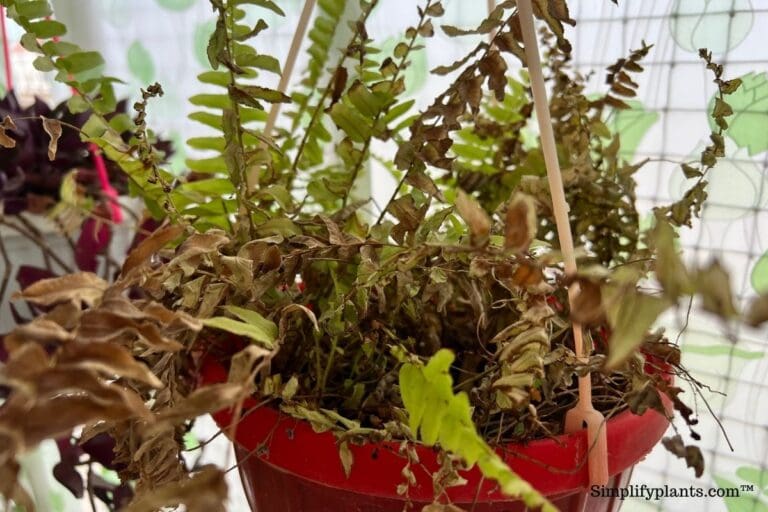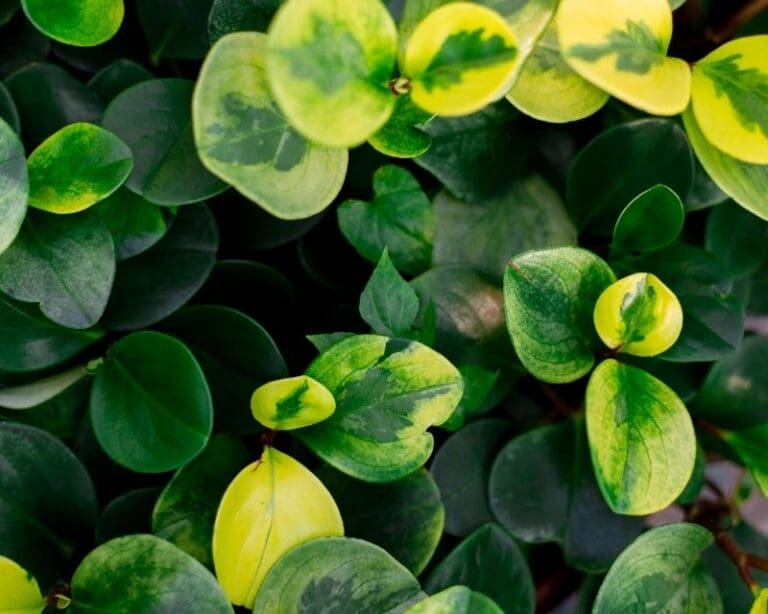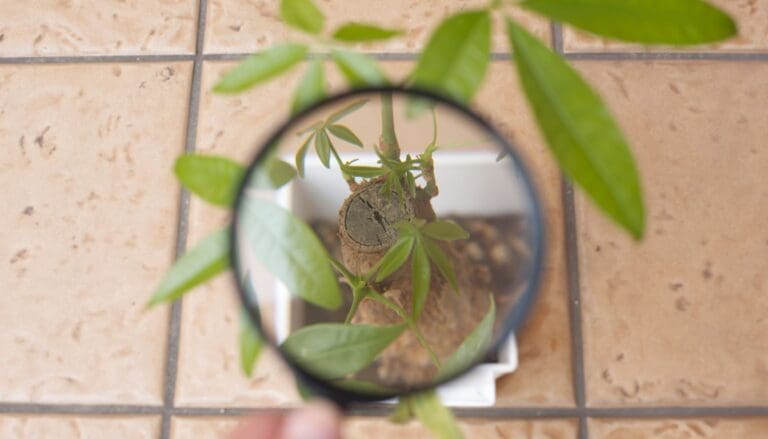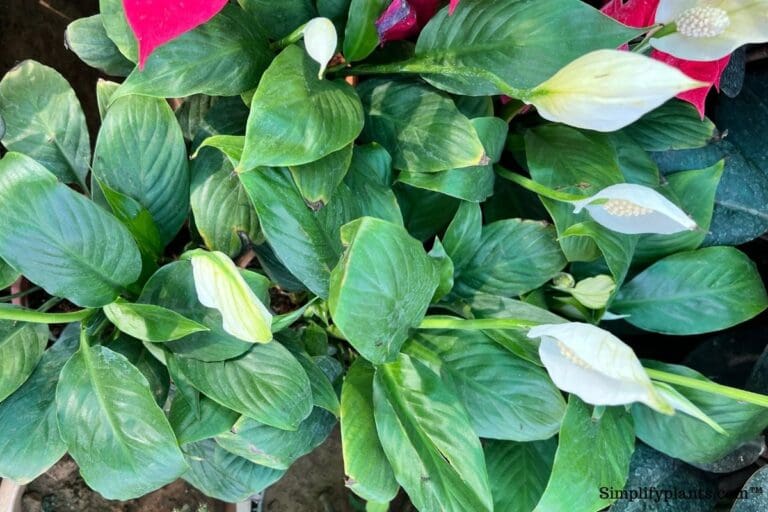Why Is My Peperomia Leaves Soft? (Possible Problems+Solutions)
Peperomia plants are perennial epiphytes that are mostly semi-succulent. Although they are pretty easygoing, these ornamental plants can develop health problems like any other plant species.
Peperomia doesn’t like to be in constant moisture, but leaving your plant under-watered for long may lead to several health complications. Leaves may turn quite soft, limp, and droopy if you let your peperomia soil dry out completely.
You might become extremely worried about noticing the soft and droopy leaves on your plant. However, if you notice the change at an early stage without any other warning signs like browning or yellowing of leaves, you can fix the problem with some careful efforts.
The primary cause of soft leaves in peperomia is overwatering and diseases. Try to move the plant to a spot where it gets bright indirect light and treat any underlying conditions. Water the plant only when the soil gets somewhat dry and fertilize the plant once a month during the growing season.
Below, you will learn about a few common reasons why your peperomia has soft leaves.

Please note: Simplify Plants is reader-supported. Some links in the post are affiliate links and I get a commission from purchases made through links in the post.
Why is my peperomia soft?
There is not one definite problem that can lead to soft leaves on peperomia. There are different reasons, and it is up to you to identify what is wrong.
Now let’s discuss the problems.
Underwatering

One of the most common causes of peperomia leaves becoming soft and thin is lack of water. Peperomias are semi-succulents, and hence they have comparatively thick leaves due to the accumulation of water.
A deficit in physiological water content forces these plants to pull out water from the leaves through the vascular system, leaving the leaves soft and limp.
How to fix the problem?
We are here to guide you to prevent the consequences of underwatering by adopting simple methods.
- After noticing any sign of overwatering on your plant’s leaves, do not start pouring a wholesome amount of water at once. First, understand the real cause by inspecting the soil condition.
- Lift your plant. If it feels light and the soil mix appears dry and loose or cracked, underwatering is the most probable cause.
- Generally, extremely dried-out soil loosens the grip from the pot’s wall.
- The best way to revive your underwatered peperomia is by watering it a little bit once a day for a week.
- After noticing a positive change, get back to a routine.
- You can also follow the capillary method of watering by first misting the soil and then slowly applying ½- 1 glass of water. This allows a uniform distribution of water into the soil mix.
- I recommend a moisture meter if you want to check the exact water requirements of your plant.
- You can consider investing in a self-watering pot if you have a tight schedule and don’t want to worry about watering your peperomia.
Things to avoid:
- Never drown your plant to overcompensate the lack of water. This can cause more harm to the plant and create stress.
- Relating thin, soft leaves every time with underwatering is not justifiable. There can be other causes too.
Also read: How Often To Water Peperomia? (Peperomia Water Requirements)
Overwatering

Now, it may seem slightly confusing to you as we have already discussed the role of underwatering in causing soft leaves among Peperomia plants. Unfortunately, overwatering can also have the same effect.
Overwatering your plant causes root rot as the roots stay in the waterlogged soil for an extended period, preventing the plant from absorbing the needed water and nutrients.
As a result, the stem becomes weak to hold the plant up. The deficit of water and nutrients in the plant’s body results in a drooping stem, soft-thin leaves due to the massive decrease in osmotic pressure.
How to fix the problem?
- If you suspect root rot due to overwatering, take the plant carefully out of the pot and inspect the roots.
- If you notice any decaying roots, trim them immediately with sterilized pruners or garden shears.
- The plant will not regain its strength unless the potting medium is suitable. Make sure the potting medium is not damp or soggy. This will further create complications.
- Do not wait for the soil to dry out naturally. Instead, apply a fresh mix for repotting the plant.
- Check the soil condition by inserting your finger or wooden stick at least 2” deep into the soil before watering. If the inserted object remains dry, only then apply water.
- Be very careful with watering during winter months, as the plants’ water needs decrease during this dormant phase.
- Again, getting a moisture meter will help you a lot in this area too.
The adjustment between underwatering and overwatering may appear tricky to beginners but don’t worry. You will get there slowly.
Also read: How To Save Overwatered Peperomia?
Lack of humidity

Lack of humidity is an actual problem for peperomia when it comes to leaves’ health. If watering of the plant is in limit and adequately done, but still you are witnessing soft, limp leaves, it can be due to the low moisture content.
This is the alarming cause for peperomias drying out during the winter. The rate of transpiration from the leaves is inversely proportional to the humidity of the atmosphere. The lower the humidity, the higher is the transpiration rate.
As a result, plants lose water rapidly through the stomata, resulting in water deficiency. Hence the leaves droop down and become soft.
This problem is most common during winter. Less ventilation further complicates this situation as the air dries out much quicker.
Also read: Do Peperomia Like To Be Misted? (+Humidity Guide)
How to fix the problem?
Here are some tips that are sure to help you increase the humidity level for your peperomia.
- Mist the leaves: Misting your peperomia a couple of times a week will help the plant. Use a spray bottle for this. Misting is an easy way to increase the surrounding humidity.
Note: Try to mist your plant in the morning as it will allow the moisture to evaporate from the leaves. Misting during the night when the temperature falls may prove harmful for the plants as they are likely to be affected by root rot due to dampness.

- Group your plants: Grouping your plants, especially during wintertime, will help increase surrounding humidity because of the transpiration process of the plants. The plants will be able to exchange moisture between themselves.
- Using a pebble tray: This is the best solution you can adapt when your peperomia leaves become thin and soft due to lack of humidity.
This will require a little DIY. All you need to do is to place some stones on a tray and add water to it. Now let your Peperomia rest on the stones throughout the day. The water will evaporate, increasing the humidity around your Peperomia.
While using a pebble tray, keep one thing in mind: the roots should not sit in the water.
- Relocate the plant: You can move your peperomia to your bathroom or kitchen area as humidity levels in these places are generally high.
Just be careful not to keep your plant near the oven or cooker, as the excess heat generated by these devices will create more problems.
- Install a humidifier: If you know that there’s a humidity deficit at your place, you can go for a humidifier. This device helps maintain a consistent humidity level.
Cold temperature

Cold temperature is another potential cause of soft leaves in Peperomia. Peperomia generally thrive well in 55-75 degrees temperature. Too much chill and cold drafts can shock the plant and hinder its growth.
How to fix the problem?
- Make sure you have a proper insulating system if you are staying in a freezing zone.
- Keep your peperomias away from glass windows to protect them from cold drafts.
- Considering the winter months, you can invest in a heating pad and install it near your plants after rubbing them together.
- Move your peperomia away from the air conditioning vents.
Things to avoid: Don’t water your plant frequently as it will further decrease the temperature.
Excess warm temperature
You should keep your peperomia plant away from excess heat. A rise in environmental temperature increases the rate of transpiration. This excess loss of water from the leaves makes them soft and limp.
Moreover, hot drafts drain moisture from the plants.
How to fix the problem?
- Misting can be applied to the plant as it cools down its body temperature due to water evaporation.
- Allow free movement of fresh air into the room.
- Clean the dust from the leaves as dust particles prevent the plant’s body heat from escaping.
Things to avoid:
- Don’t place your peperomia under direct sun rays.
- Don’t keep your peperomia near any heat-generating equipment.
Disease, fertilizers, and pests
Besides all the leading causes, other factors like plant disease, pest infestation, and mishandling of fertilizers can also promote this health issue in Peperomia.
Inapproproiate fertilization

The deposition of excess fertilizer in the soil creates a load on the plant by increasing the amount of inorganic components in the soil.
It changes the pH level of the soil and alters the absorption process of the plant. Due to this, plants are unable to absorb sufficient water from the soil by osmosis.
How to fix the problem?
- Maintain the exact quantity of the fertilizers.
- Always use a diluted mixture.
- Apply fertilizers that are primarily rich in nitrogen and iron.
- Apply the mixture once a month during summer and stop fertilizing in winter.
Things to avoid: Never apply fertilizers on the leaves.
Also read: Do Peperomia Plants Need Fertilizer? (+Best Fertilizer Pick)
Pest infestation

Peperomias are not prone to pest attacks. But, few insects like spider mites, aphids, scales, or mealybugs can suck the moisture from the leaves, leaving them limp and soft.
These pest-infested leaves finally dry out and drop.
How to fix the problem?
- Spray a powerful stream of water on the plant to wash the pests away.
- Apply any commercial or homemade insecticides like a diluted mixture of neem oil (1 teaspoon of neem extract into 2 cups of water) on the upper and lower surface of the affected leaves.
- To remove pests like mealybugs, you can use insecticidal soaps.
Also read: Do Peperomia Plants Attract Bugs? (Identification+How To Get Rid)
Diseases
Few fungal and bacterial infections, such as leaf spot disease, can harm the leaves. These infections make the plant more susceptible to pest infestation also.
How to fix the problem?
- Isolate the affected plant immediately.
- Use fungicide solutions.
- Sterilize gardening equipment before use.
- If the infection has affected the whole plant, it is better to discard it.
These are the most common reasons for causing soft, limp, and thin leaves in Peperomia. To deal with these issues, keep a careful check regularly on your peperomia plant.
How to fix soft leaves on peperomia?

People are often found asking for remedies to revive their soft peperomia.
To revive your soft Peperomia, you first need to identify the potential reason for it. In most instances, underwatering is the culprit. If that is the reason, set your plant in a deep saucer containing water for 10-15 minutes. This will allow the peperomia to absorb water and revive with firm leaves within a few hours.
You must apply the above process if the soil becomes dry. If the soil is wet, but still the leaves look limp, it might be due to root rot. It would be best to carry out repotting and changing of soil mix in such cases.
Select a pot with suitable drainage holes and place it along with your plant under bright indirect sunlight.
Plant parents get nervous with a drooping plant and soft leaves. Many ask about the possibility of droopy, soft leaves to recover.
Early measures taken are always helpful for the plant.
If traced at the beginning, you can control some issues. Like limping and softening of peperomia leaves due to frost attack or temperature rise is generally recovered by the plant itself.
Few issues like fertilizing are hard to determine. The leaves that are affected due to mishandling of watering processes, different diseases take a comparatively long time to recover.
You must discard plants with extreme damage to keep other plants safe.
To revive your peperomia’s health, you can cut off-dry, pale, droopy, and soft leaves only if 50% of the leaves are damaged. Cutting off these leaves allows the healthy foliage to receive sufficient nutrients. This induces rapid growth.
Soft leaves are typical in peperomia plants, with many causative factors behind them. Most of the causes are easy to avoid. A little knowledge of your plant’s needs and working on it accordingly will help your epiphytic friend to grow lavishly.
Ref: University of Florida, Sage Journal, University of Vermont, New Jersey Agricultural Experiment Station Rutgers, The University of Arkansas, Britannica, Wikipedia, Peperomia Diseases, NC State University.
Recommended Garden Supplies
| Product Image | Our Recommended Gardening Supplies | Check Offers! |
|---|---|---|
Top Top
Top
Top
Top
Top
Top
Top
Top | rePotme Houseplant and Tropical Classic Potting Soil Mix | Check Offer On Amazon |
 Top
Top
Top
Top
Top
Top
Top
Top | Espoma Organic Indoor Plant Food | Check Offer On Amazon |
 Top
Top
Top
Top
Top
Top
Top
Top | GooingTop LED Grow Light 6000K Full Spectrum Clip Plant Growing Lamp | Check Offer On Amazon |
 Top
Top
Top
Top
Top
Top
Top
Top | Soil Moisture Meter | Check Offer On Amazon |
 Top
Top
Top
Top
Top
Top
Top
Top | Govee Hygrometer Thermometer, Bluetooth Enabled! | Check Offer On Amazon |
 Top
Top | LEVOIT Humidifiers for Large Room(Best For Plants) | Check Offer On Amazon |
 Top
Top
Top
Top
Top
Top
Top
Top | Upgraded DIY Automatic Drip Irrigation Kit, 15 Potted Houseplants Support | Check Offer On Amazon |
 Top
Top
Top
Top
Top
Top
Top
Top | Stainless Steel Heavy Duty Gardening Tool Set | Check Offer On Amazon |
 Top
Top
Top
Top
Top
Top
Top
Top | Bonide Insecticidal Soap | Check Offer On Amazon |
 Top
Top
Top
Top
Top
Top
Top
Top | Bonide 32 oz Spray Neem Oil for Organic Gardening | Check Offer On Amazon |
 Top
Top
Top
Top
Top
Top
Top
Top | Garden Safe Fungicide | Check Offer On Amazon |






